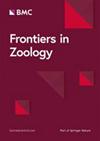蝉复杂共生系统中内共生体的分离为了解食液昆虫的微生物共生和共生器官的进化动态提供了新的视角
IF 2.6
2区 生物学
Q1 ZOOLOGY
引用次数: 0
摘要
昆虫中最奇特的共生系统出现在半翅目青蝉亚目,这为揭示复杂的昆虫-微生物共生提供了独特的视角。我们研究了六种蝉中与细菌体和脂肪体相关的共生体,并比较了不同物种卵巢中相关共生体的传代细胞数量比。我们发现,在若虫期,鞘氨醇和霍奇金菌或一种酵母样真菌共生体(YLS)被细菌体从宿主的其他组织中分离出来,然后在宿主的发育过程中,其中一些可能迁移到其他器官(即脂肪体和卵巢)。特别是,YLS 与 Sulcia 一起驻留在每个卵的 "共生体球 "和幼若虫的细菌体中,但在大多数无霍奇金菌的蝉中,YLS 最后迁移到成虫的脂肪体中,而在其他少数物种中,YLS 同时驻留在成虫的细菌体鞘和脂肪体中。在不同物种中,卵巢中传播的Sulcia/YLS或Sulcia/Hodgkinia细胞数量比差异很大,这可能与共生体的分布和/或品系分裂有关。在某些物种中,立克次体定位于细菌体和脂肪体的细胞核中,但未观察到立克次体被传播到卵巢中,这表明这种共生体可能是从环境中或从父亲传给后代获得的。共生体经虫体传播过程的巨大差异表明,共生体传播的细胞机制是复杂的。我们的研究结果可能会为昆虫与微生物的共生提供新的见解。本文章由计算机程序翻译,如有差异,请以英文原文为准。
Segregation of endosymbionts in complex symbiotic system of cicadas providing novel insights into microbial symbioses and evolutionary dynamics of symbiotic organs in sap-feeding insects
The most extraordinary systems of symbiosis in insects are found in the suborder Auchenorrhyncha of Hemiptera, which provide unique perspectives for uncovering complicated insect-microbe symbiosis. We investigated symbionts associated with bacteriomes and fat bodies in six cicada species, and compared transmitted cell number ratio of related symbionts in ovaries among species. We reveal that Sulcia and Hodgkinia or a yeast-like fungal symbiont (YLS) are segregated from other host tissues by the bacteriomes in the nymphal stage, then some of them may migrate to other organs (i.e., fat bodies and ovaries) during host development. Particularly, YLS resides together with Sulcia in the “symbiont ball” of each egg and the bacteriomes of young-instar nymphs, but finally migrates to the fat bodies of adults in the majority of Hodgkinia-free cicadas, whereas it resides in both bacteriome sheath and fat bodies of adults in a few other species. The transmitted Sulcia/YLS or Sulcia/Hodgkinia cell number ratio in ovaries varies significantly among species, which could be related to the distribution and/or lineage splitting of symbiont(s). Rickettsia localizes to the nuclei of bacteriomes and fat bodies in some species, but it was not observed to be transmitted to the ovaries, indicating that this symbiont may be acquired from environments or from father to offspring. The considerable difference in the transovarial transmission process of symbionts suggests that cellular mechanisms underlying the symbiont transmission are complex. Our results may provide novel insights into insect-microbe symbiosis.
求助全文
通过发布文献求助,成功后即可免费获取论文全文。
去求助
来源期刊

Frontiers in Zoology
ZOOLOGY-
CiteScore
4.90
自引率
0.00%
发文量
29
审稿时长
>12 weeks
期刊介绍:
Frontiers in Zoology is an open access, peer-reviewed online journal publishing high quality research articles and reviews on all aspects of animal life.
As a biological discipline, zoology has one of the longest histories. Today it occasionally appears as though, due to the rapid expansion of life sciences, zoology has been replaced by more or less independent sub-disciplines amongst which exchange is often sparse. However, the recent advance of molecular methodology into "classical" fields of biology, and the development of theories that can explain phenomena on different levels of organisation, has led to a re-integration of zoological disciplines promoting a broader than usual approach to zoological questions. Zoology has re-emerged as an integrative discipline encompassing the most diverse aspects of animal life, from the level of the gene to the level of the ecosystem.
Frontiers in Zoology is the first open access journal focusing on zoology as a whole. It aims to represent and re-unite the various disciplines that look at animal life from different perspectives and at providing the basis for a comprehensive understanding of zoological phenomena on all levels of analysis. Frontiers in Zoology provides a unique opportunity to publish high quality research and reviews on zoological issues that will be internationally accessible to any reader at no cost.
The journal was initiated and is supported by the Deutsche Zoologische Gesellschaft, one of the largest national zoological societies with more than a century-long tradition in promoting high-level zoological research.
 求助内容:
求助内容: 应助结果提醒方式:
应助结果提醒方式:


